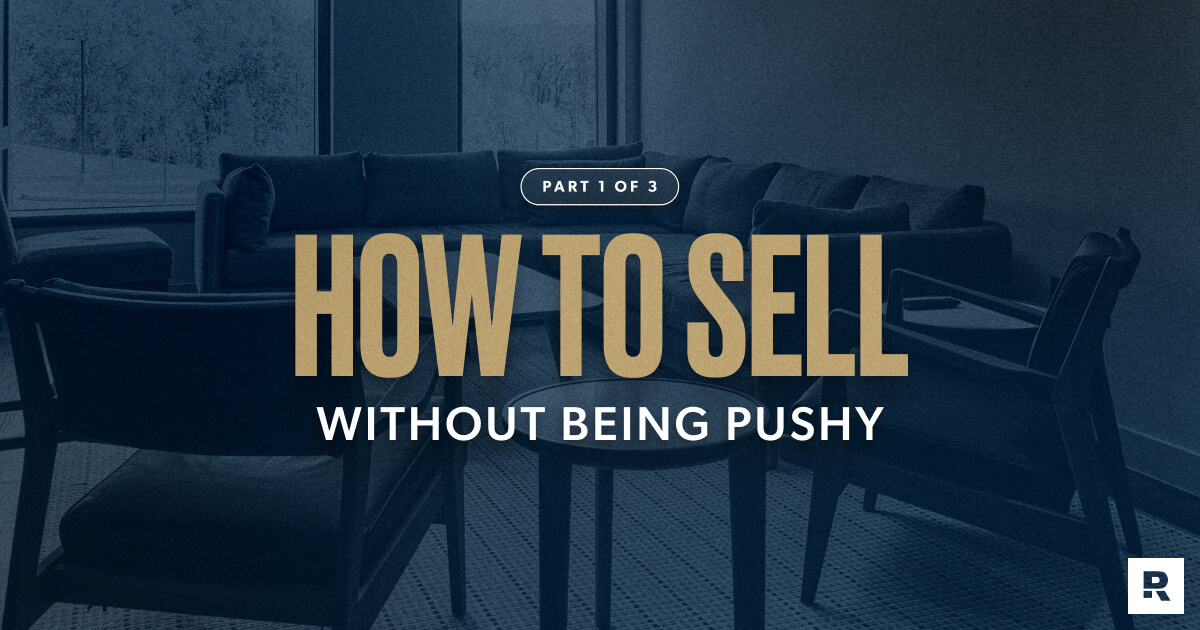Selling by Serving Part 1: How to Sell Without Being Pushy
6 Min Read | Jun 30, 2025

Key Takeaways
- Great salespeople don’t push—they guide. When you lead with care and integrity, selling becomes a way to genuinely help your customer.
- Assumptions kill sales. Don’t judge a book (or a buyer) by its cover. Listening well can unlock your biggest opportunities.
- Everyone is in sales, even if it’s not in your job title. Teachers, parents, customer service reps—anyone who influences others is selling something.
- A great buying experience creates loyal fans. From first impression to final follow-up, every interaction is part of the sale, and it all matters.
When you hear the word sales, what pops into your mind? A pushy used car salesman? A telemarketer who won’t stop calling? Maybe you think of sales as slick tactics or manipulation. But here’s the truth: When done properly, sales is none of that. At its best, selling is simply serving.
In fact, selling is about creating the right buying experience—one where the customer feels seen, heard and genuinely helped. So whether you’re leading a business, managing a team, or just handling life’s everyday interactions, knowing how to sell matters more than you think.
In Part 1 of this three-part series, entrepreneur and business leader Dave Ramsey shares one of his earliest and most memorable sales lessons in an excerpt from his small-business playbook, EntreLeadership.
In Part 2, you’ll learn three of the four steps every seller walks through with the buyer. And in Part 3, you’ll learn how to close a sale. Best of all, each part sets you up to truly serve your prospects well.
Stop winging it and start winning.
The EntreLeadership System is the small-business road map that takes the guesswork out of growing your business. To get the most out of the system, download the easy-to-follow Getting Started Guide.
From the book EntreLeadership: The Buying Experience That Taught Me a Lesson
Picture in your mind three upscale custom homes, immaculately furnished. Every detail was meticulously analyzed to make you want to own one. The main bedrooms, with rose petals floating in oversized Jacuzzi tubs, screamed romance. The kitchens were every cook’s dream. The studies, with their leather smell and wood paneling, made everyone picture curling up in front of the fireplace. Nothing was left to chance—every smell, every piece of furniture, and certainly the design of the floor plans made these model homes world-class.
In my early twenties, I had the privilege of selling custom homes using these models as a sales tool. Our welcome center was built in what would have been the garage, opening to a manicured parking lot. You could smell the money and prestige.
It was a hot August day, which was great for business. Three of us were selling that day: Jess, Roy, and me. We rotated leads as people visited. When a car pulled up, the dance began. We learned to make judgment calls based on anything signaling wealth. We were selling expensive homes, so we were looking for money.
That day, I noticed my next lead pulling up in a new Crown Victoria with no hubcaps. Weird. Out stepped Chris—shaggy beard, white T-shirt, jeans with holes in them (before we started paying extra for that) and flip-flops. I quickly decided he was just there to look and this lead was a waste. Oh well, on to the next one.
I signed him in and pointed to the models, telling him to make himself at home. If he had seemed like a real buyer, I would have walked him through the models, demonstrating all the cool features.
A few minutes later, Chris was quietly beside my desk asking for a brochure. I have to admit, while I was nice to him, I was an arrogant 22-year-old. I shamefully thought he should head back to his double-wide trailer so I could get my work done. Weekends were busy. It was important to claim prospects and make them “ours.”
On one of our busiest Sundays, Chris showed up again. This time, his wife and five small kids piled out of the Ford with no hubcaps. I was busy, so I ignored them completely. After about half an hour, there was a lull in the crowd. Chris’s wife walked up to sweetly ask some questions about the kitchen. I answered without offering to show her around. (What a snot I was.)
Another hour went by, and I was deep in conversation with a lady wearing diamonds the size of headlights when Chris appeared again with another question. I finished with the diamond lady, and Chris asked how much the big two-story model would be if we put a basement under it.
I decided to help him out by explaining how much the house would cost per month—basically telling him he couldn’t afford it. Chris got a weird look and asked, “Is it okay if I pay cash?” Cash! Are you kidding me? Suddenly, Chris and I were best friends.
It turns out he’d written software for the operations of a start-up company that had just gone public, making him a cash multimillionaire with his stock options. With Chris and his sweet wife, I made the largest sale I ever made while working there.
Selling and Selling Properly Matters
Selling and selling properly is essential in business and life. Henry Ford said, “Nothing happens until someone sells something.” Ultimately, everyone is in sales. All leaders must learn to sell. Selling is part of human interaction.
Teachers sell and persuade students to learn. Parents sell their kids on who to date. Spouses sell each other on where to eat. And in business, money is made by selling. No money is made until a sale is made.
Most people view sales as manipulative or pushy. But when done properly, sales should never be either. Buying from a great salesperson who is a professional and serves you well is a pleasurable event. My friend the great Zig Ziglar said, “Sales is nothing more than a transference of feeling. If you can make the customer feel the way you do about your product, then your customer will buy your product.”
Every Step in the Experience Is a Sale
I want you to convince your whole company that they are in sales. Customer service is sales, shipping is sales, production is sales, and quality control is sales. If the customer has a wonderful experience, they will remain a customer and send you more customers.
In fact, a great salesperson (what we call an EntreLeader, a combination of an entrepreneur and leader) makes sure they love their product and their customer. Marrying the two removes the attention to the transaction just for the sake of money, and the EntreLeader sees business as more relational than transactional.
What’s the point I’m driving home? We serve. We don’t sell.
But to serve well, we have to be intelligent and intentional about the process that humans go through in order to buy.
You’ll learn to master the sales process in Part 2 of this series and how to close a sale in Part 3.
What’s Next: Explore the System That Helped Dave Build a $250 Million Business
Since Dave’s early sales missteps, he’s grown Ramsey Solutions into a multimillion-dollar national brand. Along the way, he developed the EntreLeadership System—a proven road map for moving through five distinct stages of business.
Curious about using the system to level up with confidence? Download the EntreLeadership System Getting Started Guide.

